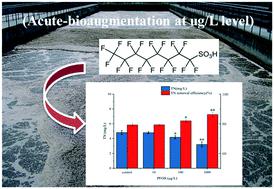当前位置:
X-MOL 学术
›
Environ. Sci.: Water Res. Technol.
›
论文详情
Our official English website, www.x-mol.net, welcomes your feedback! (Note: you will need to create a separate account there.)
Acute bio-augmentation effect of perfluorooctane sulfonic acid (PFOS) on activated sludge in biological denitrification processes and related stress mechanisms
Environmental Science: Water Research & Technology ( IF 5 ) Pub Date : 2020-12-16 , DOI: 10.1039/d0ew00954g Sheng Sheng 1, 2, 3 , Fenfei Chen 1, 2, 3 , Huabin Li 1, 2, 3 , Jin Qian 3, 4, 5, 6, 7 , Kun Li 3, 4, 5, 6, 7 , Sijing Tang 3, 4, 5, 6, 7 , Xin Tian 3, 4, 5, 6, 7
Environmental Science: Water Research & Technology ( IF 5 ) Pub Date : 2020-12-16 , DOI: 10.1039/d0ew00954g Sheng Sheng 1, 2, 3 , Fenfei Chen 1, 2, 3 , Huabin Li 1, 2, 3 , Jin Qian 3, 4, 5, 6, 7 , Kun Li 3, 4, 5, 6, 7 , Sijing Tang 3, 4, 5, 6, 7 , Xin Tian 3, 4, 5, 6, 7
Affiliation

|
Perfluorooctane sulfonic acid (PFOS) has been widely detected in wastewater treatment plants (WWTPs). Here, we investigated the nitrogen removal efficiency of activated sludge and related stress mechanisms in a sequencing batch reactor (SBR) after 8 h exposure to PFOS at 10, 100, and 1000 μg L−1. At 10 μg L−1, no significant effect (p > 0.05) was observed on total nitrogen (TN) removal. However, the TN removal efficiency significantly increased from 79.24% (control) to 81.99% and 86.21% at high concentrations (100 and 1000 μg L−1), respectively. In addition, the activities of nitrogen removal enzymes such as ammonia monooxygenase, nitrite oxidoreductase, nitrate reductase, and nitrite reductase were promoted by PFOS, which had variation trends similar to the TN removal rates. High throughput sequencing revealed that acute-term exposure to PFOS had little influence on the microbial richness (Chao) and diversity (Shannon) of activated sludge, but the relative abundance of most nitrogen-removing bacteria increased (Paracoccus, Thauera, and Comamonas increased from 0.43%, 1.78%, and 1.52% in the control to 0.60%, 2.13%, and 1.74% in SBR3, respectively), which could explain the increased nitrogen removal efficiency. This might be due to the protection of relevant bacteria by extracellular polymeric substances (EPSs), because the EPS evidently increased at 100 and 1000 μg L−1. However, an extremely significant (p < 0.01) increase of reactive oxygen species production and lactate dehydrogenase release at 100 and 1000 μg L−1 PFOS showed that PFOS caused oxidative damage and destroyed the integrity of microbial cell membranes. This indicated that PFOS has an acute bio-augmentation effect on the nitrogen removal process in WWTPs, but causes cytotoxicity after acute exposure.
中文翻译:

生物反硝化过程中全氟辛烷磺酸(PFOS)对活性污泥的急性生物增强作用及其相关的应力机理
全氟辛烷磺酸(PFOS)已在废水处理厂(WWTP)中被广泛检测到。在这里,我们研究了在10、100和1000μgL -1的PFOS中暴露8小时后,在顺序批处理反应器(SBR)中活性污泥的脱氮效率和相关的应力机理。在10μgL -1时,未观察到对总氮(TN)去除的显着影响(p > 0.05)。但是,在高浓度(100和1000μgL -1时)的TN去除效率从79.24%(对照)显着提高到81.99%和86.21%。), 分别。此外,全氟辛烷磺酸还促进了氨单氧化酶,亚硝酸盐氧化还原酶,硝酸盐还原酶和亚硝酸盐还原酶等脱氮酶的活性,其变化趋势与总氮去除率相似。高通量测序表明,急性全氟辛烷磺酸的长期暴露对活性污泥的微生物丰富度(Chao)和多样性(Shannon)几乎没有影响,但是大多数除氮细菌的相对丰度却增加了(副球菌,Thauera和Comamonas从对照中的0.43%,1.78%和1.52%分别增加到SBR3中的0.60%,2.13%和1.74%),这可以解释氮去除效率的提高。这可能是由于细胞外聚合物(EPS)对相关细菌的保护,因为EPS在100和1000μgL -1时明显增加。但是,在100和1000μgL -1 PFOS下,活性氧的产生和乳酸脱氢酶的释放显着增加(p <0.01),表明PFOS引起氧化损伤并破坏了微生物细胞膜的完整性。这表明全氟辛烷磺酸对污水处理厂的脱氮过程具有急性生物增强作用,但在急性暴露后会引起细胞毒性。
更新日期:2021-01-07
中文翻译:

生物反硝化过程中全氟辛烷磺酸(PFOS)对活性污泥的急性生物增强作用及其相关的应力机理
全氟辛烷磺酸(PFOS)已在废水处理厂(WWTP)中被广泛检测到。在这里,我们研究了在10、100和1000μgL -1的PFOS中暴露8小时后,在顺序批处理反应器(SBR)中活性污泥的脱氮效率和相关的应力机理。在10μgL -1时,未观察到对总氮(TN)去除的显着影响(p > 0.05)。但是,在高浓度(100和1000μgL -1时)的TN去除效率从79.24%(对照)显着提高到81.99%和86.21%。), 分别。此外,全氟辛烷磺酸还促进了氨单氧化酶,亚硝酸盐氧化还原酶,硝酸盐还原酶和亚硝酸盐还原酶等脱氮酶的活性,其变化趋势与总氮去除率相似。高通量测序表明,急性全氟辛烷磺酸的长期暴露对活性污泥的微生物丰富度(Chao)和多样性(Shannon)几乎没有影响,但是大多数除氮细菌的相对丰度却增加了(副球菌,Thauera和Comamonas从对照中的0.43%,1.78%和1.52%分别增加到SBR3中的0.60%,2.13%和1.74%),这可以解释氮去除效率的提高。这可能是由于细胞外聚合物(EPS)对相关细菌的保护,因为EPS在100和1000μgL -1时明显增加。但是,在100和1000μgL -1 PFOS下,活性氧的产生和乳酸脱氢酶的释放显着增加(p <0.01),表明PFOS引起氧化损伤并破坏了微生物细胞膜的完整性。这表明全氟辛烷磺酸对污水处理厂的脱氮过程具有急性生物增强作用,但在急性暴露后会引起细胞毒性。



























 京公网安备 11010802027423号
京公网安备 11010802027423号